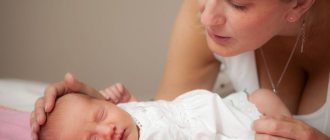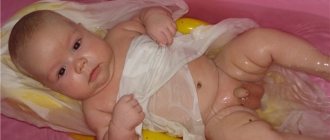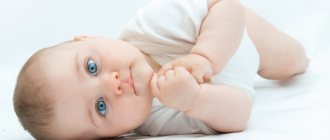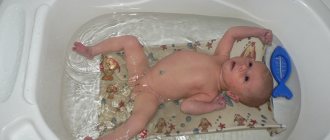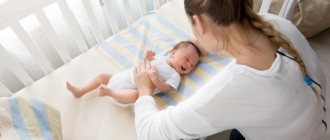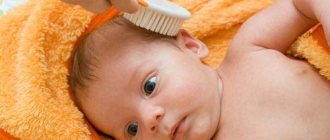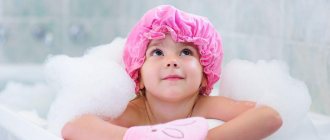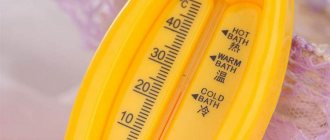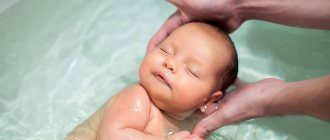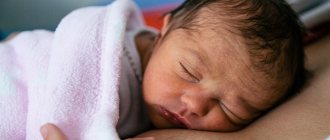Upon arrival from the maternity hospital with a newborn, the first thing young parents take care of is the comfortable placement of the baby, so that he rests after the trip and likes his new crib or cradle, regular feedings and daily hygiene. An important item on this list is swimming.
The first time is always exciting and often difficult: a newborn may react to water by crying and screaming, which will greatly alarm mom and dad. Don’t worry, in just a few days you will master all the tricks of bath procedures, and bathing will turn into a pleasant and favorite activity for your child. We will help you master the intricacies of this useful and pleasant hygienic procedure, choose products for bathing and moisturizing your skin, and answer the most common questions from moms and dads.
Bathing with an unhealed navel
During the first days, the baby is bathed with the umbilical wound still unhealed. If the umbilical stump has not yet fallen off, you can bathe the baby in warm water without adding anything to it (the wound is covered with the remains of the umbilical cord). To prevent infection, if the remainder of the umbilical cord falls off and a small wound or erosion appears, you can add a slightly pink solution of potassium permanganate to the bath water .
Important! When adding potassium permanganate, it is first diluted in a small volume of water and filtered, and only then added to the water so that the crystals do not get into the bathing water or onto the skin of the newborn. They may cause burns.
You should not get carried away with taking baths with this composition , it dries out the skin greatly, and you should not take such baths every day, only for one or two days, while the umbilical wound is fresh and has not yet become covered with a thick crust. Then you can bathe the baby in regular warm water. Also, you should not replace bathing a child with an unhealed navel with wiping the body with baby wipes - they do not replace a full bath, but only complement it.
They should be used only in extreme situations - if the hot water is turned off, you are on a trip, or there is no way to fully bathe your baby[4].
When is the best time to bathe a baby?
When is the best time to bathe a newborn? The best time for water procedures is 8-9 pm. After the bath, the baby will get tired, relax, have a good meal and quickly fall asleep until the morning. If the child cannot wait that long and, as a rule, falls asleep much earlier, then parents must adapt to the baby’s biological clock and monitor his behavior. You may need to reschedule your bathing ritual for the morning or afternoon. Once the appropriate time has been determined, it must be fixed and made permanent.
How to develop a child at 4 months - educational games and activities
When to bathe a newborn: before meals or after meals? Some babies like to take a bath before feeding, others - on a full stomach. You can only understand which option is more suitable for the baby and when it is best to feed him through experience. Just a few procedures are enough to find out your child’s preferences and make the right decision. Parents should not ignore a child’s cry; they should always remember that for the baby it is the only way to express dissatisfaction.
Important! Hygiene procedures performed in the evening will help relieve tension, relax and fall asleep. If the baby is very agitated after bathing and does not fall asleep well, it is better to wash him during the day, in between feedings.
An evening bath will calm and relax your baby.
How long after feeding should I bathe?
Parents who do not know how long after feeding a child can bathe should know that immediately after the baby has eaten, it is impossible to wash it - this can cause excessive regurgitation and the appearance of intestinal colic. Pediatricians say that the minimum amount of time that should pass after feeding is 30-40 minutes. How long after eating can you bathe your baby? Ideally, about an hour should pass between the process of eating and hygiene procedures (this time will be enough for some of the food to be completely digested).
Is it possible to bathe before eating?
It is preferable to bathe a newborn before night feeding. But babies are all different: one will be happy to bathe before eating, while another will only be well fed. Parents must take into account the child’s feelings and mood. You should not bathe your baby if he is very hungry and demands food.
In most cases, carrying out water procedures before feeding is the optimal solution. By bathing, the child will not only become clean, but will also perform certain exercises, which are quite expensive in terms of the physical effort involved. It is for this reason that it is more logical to first let the baby get thoroughly tired, only then feed him and put him to bed for a long and sound night's rest.
Dr. Komarovsky recommends following this pattern: bathing, then the last feeding and night sleep. He emphasizes that this approach has obvious advantages: it is gentle on the child’s digestive organs (physical activity does not occur on a full stomach), ease of falling asleep for the child, and long and high-quality sleep at night.
When to start bathing a newborn baby
The baby can take his first bath on the first day after being discharged from the hospital. But if the discharge was after lunch, the journey home was long and emotional, and the mother and baby were tired, you can postpone this procedure until the next day, when the baby has already become a little more comfortable at home, rested and is in a good mood. In the future, bathing can be done daily - in the evening or morning , although experts differ in their opinions regarding the frequency of hygienic baths.
Some doctors believe that hygienic baths are required daily, others are of the opinion that until the baby begins to crawl and walk, run, actively play in the sand, on the ground, or get dirty, he does not need a daily bath: it is enough to take it every other day or three times a week.
Opinions vary, but it is important to emphasize that the benefits of daily bathing are obvious . Throughout the day, bacteria, particles of exfoliating epithelium, and sweat actively accumulate on the baby’s skin. They can irritate delicate skin and provoke inflammatory processes if the baby is not washed regularly. Plus, water procedures are part of the rituals and daily routine. It would be right to bathe your child every day, but with some exceptions: if the baby is not in a good mood, the mother is tired or the house is cool, it is quite possible to do without a bath by washing the baby and changing the diaper. In hot weather, when the air temperature is high, even two baths a day are possible - in the morning and in the evening [1]. Kids love bathing very much: this is the time when they can once again communicate with their mother, or with their father who has come home from work, or with their older brothers and sisters. Bathing has a positive effect on physical development and improves a child's sleep .
During the procedure, talk to your baby, make him feel protected, dim the lights, or turn on pleasant music.
What does proper bathing provide?
According to Dr. Komarovsky, properly bathing a child is not only cleansing his skin and hair, but also a fun activity during which his emotional and mental development occurs. Water procedures contain game elements.
Proper bathing during the period voiced by Evgeny Komarovsky causes the child to quickly fall asleep and have quality rest throughout the night. The child will sleep long and soundly. There is nothing surprising in this opinion of the pediatrician, because intense movements of the baby in cool water will increase the load on his cardiovascular and muscular systems. He will be tired, but he will be happy, which is why he will quickly fall asleep in a good mood.
Dr. Komarovsky believes that a massage before bathing can enhance the effect of water procedures and induce even deeper sleep. And as you know, a child’s sound sleep ensures his mother’s long and restful sleep.
Approximately what time should you bathe a newborn?
What time do you bathe your newborn baby before bed?
At 21.00 the child should sleep, already washed and fed.
Therefore, bathing of newborn babies (the first three months of life) should be around 20.00
For children after six months, bathing can be shifted half an hour later - 20.30.
But at 21.00 the child must be put to bed.
Bath before the last evening feeding.
However, we must remember that some children are overstimulated by bathing and this must be taken into account as an individual characteristic of the child. Therefore, if the baby cannot sleep after bathing and becomes active, then bathing should be shifted by a couple of hours, that is, to 18.00-18.30
All the parents' talk about how they need to be laid out in a way that is convenient for them is a complete disgrace. There is a daily routine for children established by pediatrics (it is different for different ages, but the differences are not very strong) and it MUST be followed regardless of what the parents’ daily routine is.
The norm has been established and we must strive for it, because then the parents themselves do not know: why the child gets tired quickly, why he eats poorly, why he is capricious, etc. And the answer to these questions is very often the same - NO DAY ROUTINE.
A daily routine is set two to three weeks in advance (this is on average).
Bathing a baby is not just a hygienic procedure, but a whole ritual that brings pleasure to both mother and baby. But that will come later. And just after returning from the maternity hospital, a young mother always asks the question: how to bathe a newborn baby for the first time at home? And even experienced mothers, holding a tiny baby in their arms, try to repeat the “theory” in order to do everything correctly.
So, how to properly bathe a newborn?
Preparing for a swim
The first baths, until the baby's umbilical wound heals, can be done in a baby bath. The volume of water in it is less than in a regular bath, making it more convenient for parents to hold and wash the baby. As your child gets older, you can switch to an adult bath. Usually this is from 2-3 months of age. But do not forget about cleanliness - before bathing in a large bath, you need to wash it with soda and a sponge, then rinse thoroughly with hot water. One of the burning questions when parents are going to bathe their baby for the first time is whether to boil the water? A modern water supply system means that tap water is safe for children and adults, so there is no need for additional boiling. If you use water from open sources (wells, rivers, lakes), it is better to boil it in advance and cool it to the desired temperature at least in the first weeks of life, while the umbilical wound is healing.
Before swimming, be sure to prepare in advance:
- a towel (you can have a corner to cover your head),
- clean diaper,
- means for bathing and moisturizing the skin, protective diaper cream;
- clean clothes or diapers.
Lay out everything you need on the changing table or in the place where you will dress your baby so that everything is at hand.
Organization of bathing
To ensure that water procedures bring only pleasant emotions and are not accompanied by fuss, prepare everything you need in advance.
What you need for swimming
Bath. Is it possible to bathe a child in a large bathtub? In fact, there are no clear recommendations. What kind of bath it will be - a small children's bath or a regular large one - depends on your preferences. Each has its own advantages. For example, bathing a newborn in a bathtub is convenient because you only need a little water. And it doesn’t take long to wash the bathtub itself. And in a large bathroom, the water cools slowly, so the baby can “swim” to his heart’s content.
Before bathing your baby, wash the bathtub. This should be done with baby soap, baking soda, but not with chlorine-containing products. Afterwards, rinse thoroughly.
Bathing thermometer. There are electronic options that signal when water temperatures are below or above normal. They are completely safe and can also serve as a toy, as they are made of harmless rubber materials. You can also choose infrared ones - they measure temperature in a non-contact way, or regular mercury-free thermometers. The main requirement for thermometers is safety and accuracy of measurements.
Towel. It should be soft and of high quality. Rough material, towels with embroidery, beads, and sequins are not suitable. It is also worth paying attention to the size: if the product is large enough, the baby can be completely wrapped. And towels with a corner are especially convenient - the baby’s head will always be protected from drafts.
Hygiene products - bathing gels, soaps intended for children's skin. It should be used no more than 1 - 2 times a week. No shampoo needed. At birth, the skin pH of babies is neutral; within a few weeks the reaction becomes acidic, which provides complete protection against bacteria. If you use alkaline soaps, the pH will change and the barrier properties of the skin will decrease. This is a prerequisite for the development of inflammatory diseases, for example, diaper dermatitis. Therefore, bathe in ordinary water.
A slide or hammock is a convenient device, especially if the mother bathes the baby alone. The baby lies on a slide, so there is no need to support him. Choose a fixture that can be securely attached to the bathtub. Experts are wary of swimming circles: they can cause damage to the cervical spine or other parts of it.
You also need to prepare cosmetics. Select the cream based on the type of skin the baby has. For example, if there is a predisposition to atopic dermatitis (dry skin, there are close relatives with this diagnosis), prepare emollients.
Clothes you will need are diapers, a hat, a diaper, a vest, rompers, and a hair brush. If you need to treat the umbilical wound, use cotton swabs with a limiter, a solution of brilliant green.
Water preparation
Draw water directly from the tap. If the water hardness is high, you should install a main filter. There is no need to bathe a newborn in boiled water: it is a waste of time and effort. Add enough water so that it is just above half of the bath. If you want to carry out water procedures in a large bath, let it be at such a level that you can safely hold the baby.
Have an extra ladle or bowl of water ready to rinse the baby.
Bathing water temperature
The temperature should be measured with a special water thermometer. Trying with your elbow can be dangerous, as tactile sensitivity depends on many factors and the values may be unreliable. Optimal values are 37°C.
You should not install a separate heater in the bathroom: the air temperature should be the same as in the other rooms. But the baby needs to be protected from drafts, so close the windows and vents.
Additives to water
Parents are concerned about the question: is it possible to bathe a child in various solutions and is potassium permanganate necessary? Be careful with the potassium permanganate solution. For a good effect, you need a concentrated solution, which is dangerous for the body. But a weak solution will not be of any use. Therefore, fill the bath with plain water without additives.
If there are any problems: rash, irritation, you can add a decoction of string, chamomile. There are also soothing or drying herbs. Your doctor will tell you which one to use in your case, based on the problems you have. Take ready-made dried herbs at the pharmacy, do not use raw materials prepared yourself: this may be unsafe. After preparing the decoction, be sure to strain it before pouring it into the bath. You should be careful if you have close relatives with allergies, bronchial asthma and other allergic diseases.
Preparing the child
The baby should be calm and well-fed. Undress and place on a changing table or bed. Give a massage, stroking the arms, legs, tummy, back. Place on your tummy for a few minutes. If his diaper is dirty, take it off and wash his bottom.
Water temperature for baby's first bath
In order for hygiene procedures to be enjoyable and safe, you need to select the correct water temperature . When bathing a newborn every day, you need to pour water into the bath approximately equal to 37-38 degrees . Special water thermometers can be used to measure temperature. They are usually made in the form of funny figures, brightly colored animals, the child likes them and attracts attention. But it is quite possible to do without this device, determining the temperature of the water with the back of the hand or elbow (as our mothers did). The water should be approximately equal to body temperature and feel comfortable. You should not rely on perception from the fingers of the hand; they are more resistant to temperature: more sensitive skin on the elbow or back of the hand will provide more objective information.
Important! If the house has a gas water heater or an electric water heater, and even when drawing water from a hot tap of the central water supply, always first check the temperature of the water before lowering the baby there (even if you initially drew water at the desired temperature). Due to changes in water pressure, the temperature may rise sharply and the water will be too hot. This is dangerous for the delicate skin of babies due to burns!
Bathing products
Always bathe your newborn only with specifically designed baby products [2].
Adult shower gels, shampoos or regular bar soap may be too aggressive and allergenic for the delicate skin of babies.
For daily hygiene, your baby will need:
- body and hair cleansing gel
- milk or cream to moisturize the skin
- diaper cream to prevent redness
It is desirable that children's products be labeled 0+ , contain predominantly natural ingredients , and also have a hypoallergenic composition and clinically proven effectiveness.
Mustela Soft Bathing Gel contains 90% ingredients of natural origin. Perseose contained in Avocado promotes the natural development of baby's skin, supporting its own protection and hydration.
The gel gently cleanses delicate fragile skin, softens the effect of tap water, does not contain soap and does not sting the eyes.
How to bathe a baby correctly
The first time the baby is bathed, hold it in one hand, placing the head in the elbow , supporting the baby’s buttocks with the palm, and gradually immersing him in the water. You can ask your dad or any other family member for help. Modern bathtubs are often equipped with a special slide, which helps to support the baby in the correct, comfortable position when bathing. The slide is covered with a clean diaper, on which the baby is placed on top, placing the head in a special recess. First , the baby needs to be gradually immersed in water, starting from the heels and lowering into the water to approximately chest level. You need to give him a little time to get used to the temperature , carefully pouring water on his chest and tummy.
Bathing a child begins with the face and head , rinsing them with clean water until it becomes soapy. You can use a soft sponge, cotton balls, or just your hand to wash your skin. The face is wiped in the direction from the forehead to the chin, running the hand or sponge from the middle of the forehead towards the temple, cheeks and cheekbones on the left and right. Gently wipe the area between the eyebrows and nose to prevent water from entering the nostrils.
The head is washed in the direction from the forehead to the back of the head so that water and soap suds do not get into the baby’s eyes. First, apply a few drops of shampoo to your hand, foam and evenly cover your head with foam, gently massaging the hairs and skin on your head with your fingertips. The shampoo is also washed off with water, using gentle moving movements from front to back, pouring it from a ladle or scooping it up with your hand. Don't forget about the area behind the ears , dirt, sweat and shampoo residues often accumulate there. This area should be rinsed well with clean water. Then they wash the neck, shoulders and arms, carefully opening and washing all the folds with soapy foam and then with clean water. The next stage is washing the tummy and legs, including the area of the popliteal folds and the spaces between the toes.
The last step is to wash the diaper area , thoroughly washing the groin, buttock folds and genital area. This is important because bacteria from the intestines get into the water when washed off and it is undesirable for them to then get on the face or other parts of the body. At the end of bathing, the baby should be rinsed with clean water from a ladle. It can be 1-2 degrees lower than the temperature of the water in the bath.
Important! Do not use the shower to rinse - this is justified for safety reasons. In the shower, it is difficult to adjust the water to the desired temperature; due to changes in water pressure, it can become too hot. This is dangerous for the skin and can cause burns. In addition, the sound of the shower and elastic jets can frighten the baby and create a negative reaction to bathing.
Completion of water procedures
After bathing, the baby definitely needs to warm up, wrap him in a warm cotton towel and take him out of the bathroom, moving to the changing table or any convenient place. It is important not to rub his skin to remove any remaining moisture, but to gently blot all open areas of the body and all skin folds on the neck, arms, butt and legs. It is important to dry the baby and carry out all subsequent procedures in a warm room so that there is no sudden temperature change. Wet skin actively evaporates water and becomes hypothermic faster. If the baby's hair is long, after blotting the skin on the head, you can put a thin cotton cap on the baby for 1-2 hours until the hair is dry. There is no need to wear a cap all the time.
Benefits of bathing
Bathing a newborn baby is not only about ensuring hygienic cleanliness. This procedure has a huge impact on the psycho-emotional and intellectual development of the baby. During bathing, all muscles relax, hypertonicity is relieved, gross motor skills develop, and the body hardens. All nerve receptors react positively to the aquatic environment. The baby's motor functions are improving. Positive emotions, vivid impressions - all this has a positive effect on the nervous system.
The baby is less capricious and sleeps more soundly. Water relieves pain caused by colic in the abdomen. The emotional closeness of the child and parents during bathing creates the prerequisites for the successful socialization of the baby.
You must select a specific time. Each family chooses its own bathing time, taking into account the peculiarities of the baby’s daily routine and taking into account the interests of adults.
Several requirements must be met:
- You should not bathe immediately after feeding, so that the baby does not regurgitate everything.
- The child should not be hungry during the procedure, otherwise he will be capricious.
- Most often, the procedure is carried out in the evening, before the penultimate feeding.
- For children with pronounced hyperactivity, bathing has a stimulating effect. For such children, it is better to schedule the procedure for the day.
Moisturizing and treating the diaper area
The last stage is caring for the skin of the body, treating the perineal area and putting on a clean diaper. The skin of a newborn baby is very fragile, the epidermal barrier has not yet fully formed, and it is susceptible to moisture loss. Therefore, it is necessary to moisturize the skin on the body so that it does not dry out, peel, or become inflamed [3].
Body milk "Hydra Bebe" delicately moisturizes for a long time , strengthens the skin barrier and cares for the baby's skin.
Contains 97% ingredients of natural origin.
Apply a small amount of milk to your hands and spread over the body with soft stroking movements, starting from the neck and shoulders, chest, back, ending with the legs, from the hip to the foot. In addition to care, it is also a light massage that has a calming effect.
Before putting on a clean diaper, you need to reliably protect the delicate skin in the area under the diaper from the aggressive effects of urine and feces. To create a protective barrier, you should use a special diaper cream.
Diaper cream 1 2 3 protects, quickly soothes and restores the skin without interfering with skin breathing. Effective in 80% of cases from the first applications for redness*
This cream can be used for prevention and for redness in the diaper area and skin folds.
After swimming
After a correctly carried out process, the child is in a good mood, he is tired and wants to sleep.
- Wrap in a warm diaper or towel. Feed.
- Lay it on your back and check again whether the folds on your body are dry or not. Blot with a soft cloth where there is moisture.
- Treat dry areas with baby oil and redness in the folds with talcum powder or powder.
- Before swaddling or putting on a vest, wipe the ears. Wear a cap that tightly covers your ears.
- Put on a diaper. Swaddle or put on clean clothes. For sound sleep, experts recommend swaddling children up to 3 months. Swaddling is also a means of preventing colic in infants.
Should you use herbs?
Parents are often advised to bathe their newborn baby in a bath with the addition of decoctions of various herbs - chamomile decoction, infusion of string or celandine. Caution must be exercised with this advice. Herbal infusions and decoctions are not as harmless as parents may think. Firstly, they can be allergenic to the baby’s skin and cause rashes. Secondly, herbal decoctions, especially herbs, greatly dry the skin and can provoke increased peeling. Therefore, you do not need to use these components yourself. If necessary, the pediatrician, who comes for regular visits, will advise bathing the baby in herbs. This is usually required when prickly heat appears, severe sweating in the area of the folds, or if there is a tendency to dermatitis.
Adding medicinal herbs to the bath
The use of chamomile, string, motherwort, and valerian is best discussed with your pediatrician. If a child is prone to allergies, atopic dermatitis and diaper rash are observed, then you should not use herbs. Also, they cannot be used until the navel is completely healed.
Adding medicinal plants to the bath is useful, but everything should be in moderation. You cannot prepare herbal baths every day, and it is also important to follow the dosage.
How to prepare a herbal decoction
- pour 3-4 tablespoons of dried herbs with 1 liter of boiling water;
- cover with a lid, leave to infuse for 1 hour;
- Before adding to water, strain through a sieve or cheesecloth.
How often to wash a newborn's hair
Newborn babies do not get very dirty, so they need to wash their heads with shampoo no more than 2-3 times a week. But the baby's head can sweat a lot, so during daily bathing you can simply wash it with warm water. If there are crusts on your head, there is no need to remove them by force. Wet the baby's head, leave for a few minutes and wash off those crusts that peel off on their own, or use special products to soften and then carefully wash off the crusts.
Mustela milk crust foaming shampoo facilitates the removal of milk crusts in 90% of cases**
